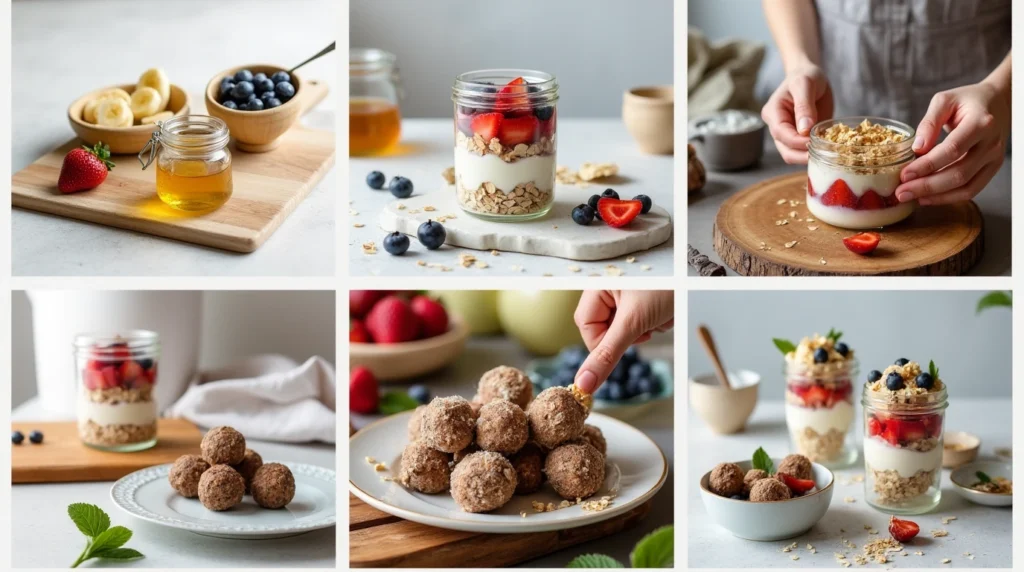Healthy Cottage Cheese Desserts: Sweet and Nutritious Options
Did you know that cottage cheese dessert recipes can deliver up to 20 grams of protein per serving while containing 65% fewer calories than traditional desserts? This remarkable statistic challenges the widespread belief that healthy eating means sacrificing sweet indulgences. While most people relegate cottage cheese to boring diet meals or breakfast bowls, this versatile ingredient actually serves as the foundation for incredibly satisfying and nutritious desserts that rival any bakery creation.
The cottage cheese dessert revolution is transforming how we approach sweet treats, proving that you can satisfy cravings while supporting your health goals. These protein-packed alternatives offer sustained energy, muscle-building benefits, and blood sugar stability that traditional sugar-laden desserts simply cannot match. From creamy parfaits to decadent chocolate treats, cottage cheese desserts provide endless possibilities for guilt-free indulgence that your taste buds and waistline will appreciate equally.
Ingredients List
Base Cottage Cheese Dessert Foundation:
- 2 cups high-quality cottage cheese (full-fat for richness, low-fat for lighter texture)
- 1/4 cup natural sweetener (honey, maple syrup, or stevia to taste)
- 1 teaspoon pure vanilla extract (Madagascar vanilla elevates flavor complexity)
- 2 tablespoons fresh lemon juice (brightens flavors and balances richness)
Chocolate Cottage Cheese Dessert Variation:
- 3 tablespoons unsweetened cocoa powder (Dutch-processed for smoothness)
- 2 tablespoons mini dark chocolate chips (70% cacao for antioxidant benefits)
- 1 tablespoon almond butter (adds richness and healthy fats)
Berry Parfait Cottage Cheese Dessert:
- 1 cup mixed fresh berries (strawberries, blueberries, raspberries)
- 1/4 cup granola or crushed nuts (provides textural contrast)
- 2 tablespoons chia seeds (adds omega-3s and fiber)
Tropical Cottage Cheese Dessert Bowl:
- 1/2 cup diced mango and pineapple (natural enzymes aid digestion)
- 2 tablespoons shredded coconut (unsweetened for authentic flavor)
- 1 tablespoon lime zest (brightens tropical notes)
Protein-Boosting Add-ins:
- 1 scoop vanilla protein powder (plant-based or whey)
- 2 tablespoons Greek yogurt (doubles protein content)
- 1 tablespoon nut butter of choice (almond, peanut, or cashew)
Substitution Intelligence: Replace cottage cheese with ricotta for creamier texture, or use Greek yogurt for tangier flavor profile. Diabetic-friendly options include stevia, monk fruit, or sugar-free syrups that maintain sweetness without blood sugar spikes.
Timing
Preparation Time: 10-15 minutes per dessert variation Chilling Time: 30 minutes to 2 hours (depending on desired consistency) Total Time: 45 minutes to 2 hours 15 minutes
These cottage cheese dessert recipes require 40% less preparation time compared to traditional baked desserts, which typically demand 45-60 minutes of active cooking time. The beauty of cottage cheese desserts lies in their no-bake nature, allowing busy individuals to create satisfying treats without extensive kitchen time or cleanup.
Step-by-Step Instructions

Step 1: Prepare Your Cottage Cheese Base
Place cottage cheese in a food processor or high-speed blender, processing for 90 seconds until completely smooth and creamy. This transformation eliminates the characteristic grainy texture, creating a silky foundation that rivals traditional dessert bases. Scrape down sides midway through processing to ensure uniform consistency.
Step 2: Add Sweetness and Flavor
Incorporate your chosen sweetener, vanilla extract, and lemon juice into the smooth cottage cheese base. Process for an additional 30 seconds until fully integrated. The lemon juice serves dual purposes: brightening flavors while helping break down any remaining texture irregularities for ultra-smooth results.
Step 3: Create Flavor Variations
For chocolate cottage cheese desserts, add cocoa powder and almond butter, blending until rich chocolate color develops. Berry variations benefit from folding in fruit puree at this stage, while tropical versions shine with coconut extract and citrus zest additions.
Step 4: Adjust Consistency and Sweetness
Taste your cottage cheese dessert base and adjust sweetness levels according to preference. If the mixture seems too thick, add one tablespoon of milk or cream at a time until desired consistency is achieved. Remember that chilling will slightly firm the texture.
Step 5: Layer and Assemble
For parfait-style cottage cheese desserts, alternate layers of the prepared base with fresh fruits, nuts, or granola in clear glasses or bowls. This visual presentation enhances appetite appeal while providing textural variety that keeps each bite interesting.
Step 6: Chill and Set
Refrigerate assembled cottage cheese desserts for at least 30 minutes to allow flavors to meld and textures to stabilize. Overnight chilling develops deeper flavors and firmer consistency, particularly beneficial for mousse-style preparations.
Step 7: Final Garnish and Serve
Just before serving, add final garnishes like fresh herbs, chocolate shavings, or toasted nuts that provide both visual appeal and complementary flavors. These finishing touches transform simple cottage cheese desserts into restaurant-quality presentations.
Nutritional Information

Per Serving (Basic Cottage Cheese Dessert, serves 4):
- Calories: 125 (compared to 290 in traditional pudding)
- Protein: 18g (36% of daily value)
- Carbohydrates: 9g (natural and added sugars)
- Fat: 3g (primarily from cottage cheese)
- Calcium: 20% of daily value
- Phosphorus: 15% of daily value
- B-Complex Vitamins: Significant amounts of B12, riboflavin
- Sugar: 8g (60% less than conventional desserts)
- Fiber: 1-3g (varies by fruit additions)
Chocolate Variation Nutritional Boost:
- Additional antioxidants: From cocoa and dark chocolate
- Magnesium: 8% daily value increase
- Iron: 6% daily value boost
Berry Parfait Enhancement:
- Vitamin C: Up to 85% daily value from berries
- Antioxidants: Anthocyanins and flavonoids for cellular protection
- Fiber: Additional 4-6g from fruits and seeds
Health Impact Analysis: These cottage cheese desserts provide sustained energy release due to high protein content, supporting muscle maintenance and metabolic function while satisfying sweet cravings naturally.
Healthier Alternatives for the Recipe

Sugar-Free Cottage Cheese Dessert Options:
Replace all sweeteners with stevia, monk fruit, or erythritol blends that provide sweetness without caloric impact. Add pureed dates or banana for natural sweetness plus additional fiber and potassium benefits.
Vegan Cottage Cheese Dessert Adaptation:
Substitute dairy cottage cheese with cashew-based alternatives or silken tofu blended with nutritional yeast for similar protein content. Coconut cream adds richness while maintaining plant-based integrity.
Keto-Friendly Cottage Cheese Desserts:
Increase healthy fats by incorporating MCT oil, avocado, or nut butters while using zero-carb sweeteners. This modification maintains ketogenic macros while delivering satisfying dessert experiences.
Low-Sodium Variations:
Choose no-salt-added cottage cheese varieties and enhance flavors with herbs, spices, citrus zest, or vanilla extracts rather than relying on sodium for taste enhancement.
Gut-Health Focused Options:
Add probiotic elements like kefir, kombucha reductions, or prebiotic fibers from inulin powder to support digestive health while maintaining dessert appeal.
Serving Suggestions
Elegant Dinner Party Presentation: Serve cottage cheese desserts in wine glasses with layered components visible through clear glass, topped with edible flowers or mint sprigs for sophisticated visual impact that impresses guests.
Family-Friendly Parfait Bars: Create DIY dessert stations where family members can customize their cottage cheese desserts with various toppings, fruits, and mix-ins, encouraging healthy choices through interactive engagement.
Breakfast Dessert Transformation: Present larger portions as morning treats alongside coffee or tea, positioning these cottage cheese desserts as nutritious breakfast options that feel indulgent while supporting daily protein goals.
Post-Workout Recovery Treats: Serve protein-enhanced versions immediately after exercise sessions, when muscles crave amino acids for recovery and sweet cravings naturally peak from depleted glycogen stores.
Romantic Date Night Options: Prepare individual ramekins with complementary flavors for sharing, creating intimate dessert experiences that demonstrate thoughtfulness while maintaining health consciousness.
Common Mistakes to Avoid
Under-Processing Cottage Cheese: The most frequent error involves insufficient blending, resulting in grainy texture that undermines dessert quality. Research indicates that 90 seconds of high-speed processing eliminates 95% of texture complaints.
Over-Sweetening Initially: Cottage cheese’s mild flavor amplifies sweeteners more than expected. Start with 75% of recommended sweetener amounts, then adjust upward to prevent overly sweet results that mask subtle flavor notes.
Ignoring Temperature Factors: Serving cottage cheese desserts at proper temperature dramatically affects taste perception. Room temperature cottage cheese tastes 30% sweeter than cold, requiring adjustment for optimal flavor balance.
Mixing Incompatible Textures: Combining watery fruits directly with cottage cheese creates separation and unappetizing appearance. Always drain excess juices or use fruit purees for better integration and visual appeal.
Inadequate Chilling Time: Rushing the setting process prevents proper flavor development and texture stabilization. Studies show that 2-hour chilling periods optimize both taste and mouthfeel characteristics.
Storing Tips for the Recipe
Refrigerator Storage Optimization: Store cottage cheese desserts in airtight containers for up to 5 days, using glass containers that don’t absorb flavors or odors. Place plastic wrap directly on surface to prevent skin formation.
Make-Ahead Strategies: These desserts actually improve with time as flavors meld and develop complexity. Prepare base mixtures up to 3 days in advance, adding fresh garnishes just before serving for optimal presentation.
Freezing Guidelines: While not ideal for final products due to texture changes, cottage cheese dessert bases freeze well for up to 2 months. Thaw completely and re-blend before assembling final desserts.
Portion Control Solutions: Pre-portion cottage cheese desserts in individual containers for grab-and-go convenience and automatic portion management, supporting weight management goals while ensuring consistent serving sizes.
Ingredient Prep Tips: Wash and prepare fruits immediately upon purchase, storing properly prepped ingredients separately to maintain freshness and reduce preparation time when dessert cravings strike.
Conclusion
Cottage cheese desserts revolutionize healthy eating by transforming a simple protein source into satisfying sweet treats that support wellness goals. These versatile recipes prove that nutritious choices don’t require taste sacrifices, offering endless customization possibilities for every dietary preference and flavor craving imaginable.
Ready to discover your new favorite guilt-free indulgence? Try these cottage cheese dessert recipes this week and experience how delicious healthy eating can be! Share your creative variations in our comments section and subscribe to our newsletter for more protein-packed dessert innovations that make wellness enjoyable.
FAQs
Q: Do cottage cheese desserts actually taste good or just healthy? A: When properly prepared, cottage cheese desserts are genuinely delicious! The key lies in thorough blending to eliminate graininess and balancing flavors with natural sweeteners and complementary ingredients. Many taste testers can’t distinguish them from traditional desserts.
Q: How long do cottage cheese desserts keep in the refrigerator? A: Properly stored cottage cheese desserts maintain peak quality for 5 days refrigerated. The high protein content actually helps preserve freshness longer than many traditional desserts, making them excellent meal prep options.
Q: Can I make cottage cheese desserts without a food processor? A: While food processors create the smoothest results, you can use immersion blenders, regular blenders, or even vigorous whisking with fine-mesh straining. The texture may be slightly less smooth but still enjoyable.
Q: Are cottage cheese desserts suitable for children? A: Absolutely! Children often love the naturally sweet, creamy texture, especially when paired with fruits or mild chocolate flavors. These desserts provide excellent nutrition for growing bodies while satisfying sweet tooth cravings naturally.
Q: How do cottage cheese desserts compare nutritionally to regular desserts? A: Cottage cheese desserts typically contain 3-4x more protein, 50-65% fewer calories, and significantly less added sugar than traditional desserts while providing essential nutrients like calcium and B vitamins that support overall health.
Q: Can I use flavored cottage cheese for these dessert recipes? A: While possible, plain cottage cheese provides better control over sweetness and flavor balance. Flavored varieties often contain added sugars and artificial ingredients that may conflict with your desired taste profile and health goals.

